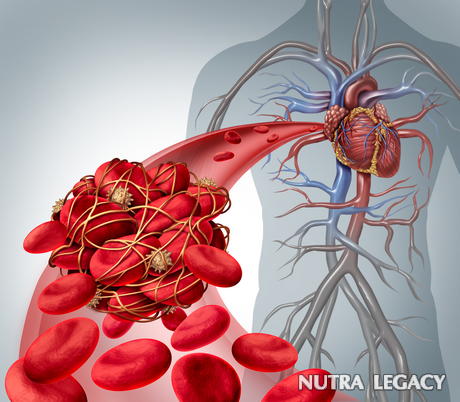4 Ways to Recognize Signs of a Blood Clot

- Blood clot formation is natural and essential but can be a problem when the blood clot results in vein or artery blockage. Blood clot prevention is important because negligence can lead to deadly results
- Some blood clot symptoms can lead to serious health problems
- Symptoms your blood clots could cause a heart attack- chest pain, radiating pain, abdominal pain and cardiac arrest
- Symptoms your blood clots could cause a stroke- one sided symptoms, loss of sensation, speech difficulties and loss of coordination
- Symptoms of blood clots forming in legs- inflamation, increased warmth, redness/pain and throbbing while walking
Blood clot formation is a a natural and essential process. Whenever we are cut, a blood clot is formed in order to stop the bleeding. However, if a blood clot results in the blockage of an artery or a vein, the results can be serious.
Our bodies create a blood clot if a blood vessel becomes damaged, and the clot then dissolves once it is healed. A thrombus occurs when a blood clot results in the obstruction or cessation of the blood flow in an artery or vein. Blood clots such as this often originate in the blood vessels of the leg. If a blood clot breaks free and then begins to travel through the body, they can cause some serious problems and possibly death.
Blood clots can cause a blockage in an artery. This in turn will cause a restriction in the supply of oxygen to an organ or organs, causing tissue damage. Blood clots like these are often responsible for cardiac arrest and strokes. For example, when a clot forms in an artery that supplies blood directly to the heart, and a blockage forms, the supply of oxygen to the associated cells becomes restricted. The consequence can be that a section of the heart dies due to being deprived of oxygen, causing a heart attack. Similarly, blood clots that restrict or block the brain’s oxygen supply can cause a stroke.
4 Signs of Blood Clots Causing Heart Attack
1. Chest pain: The first sign of a blood clot that causes a heart attack start is often chest pain.
2. Radiating pain: Patients often describe the pain as starting in the middle of the chest and radiating upward to the jaw, and onward to the arms and back.
3. Abdominal pain: Pain may also be felt in the abdomen.
4. Cardiac arrest: If a heart attack is the result, a patient might report tightness in the chest and a pounding sensation. The patient is also likely to suffer difficulty in breathing, they may vomit and they may also lose consciousness and collapse during a cardiac arrest.
4 Signs of Blood Clots Causing Stroke
1. One sided symptoms: Blood clots that result in a stroke tend to result in symptoms that are more pronounced on one side of the body (the opposite side from the affected side of the brain).
2. Loss of sensation: The result can be loss of sensation or paralysis in a leg or an arm, or on one side of the face. Blindness may also occur.
3. Speech difficulties: Speech problems may be experienced if the clot has affected the left hand side of the brain.
4. Other signs: Blood clots that cause strokes may also cause confusion, loss of balance/coordination or severe headaches.
4 Signs of Blood Clots Forming in the Legs
1. Surface veins may become inflamed, producing pain and discomfort.
2. Blood clots that form in the legs can cause increased warmth.
3. There may be swelling, redness and pain.
4. Leg blood clots may also cause the calves to throb, especially during walking.
Blood clots can cause serious consequences. If you are experiencing any signs or symptoms of a blood clot, you should consult a doctor without hesitation.
The information supplied in this article is not to be considered as medical advice and is for educational purposes only.
2 Responses to “4 Ways to Recognize Signs of a Blood Clot” | ||||||||||||||





 23 Jan 2009
23 Jan 2009
I do notice that my claves hurt much more than they should after a regular walk, but I am not experiencing any of the other symptoms mentioned about blood clots in the legs. Should I be worried or could it be something else?February 1st, 2011 at 2:53 am
I do notice that my claves hurt much more than they should after a regular walk, but I am not experiencing any of the other symptoms mentioned about blood clots in the legs. Should I be worried or could it be something else?January 31st, 2011 at 9:53 pm